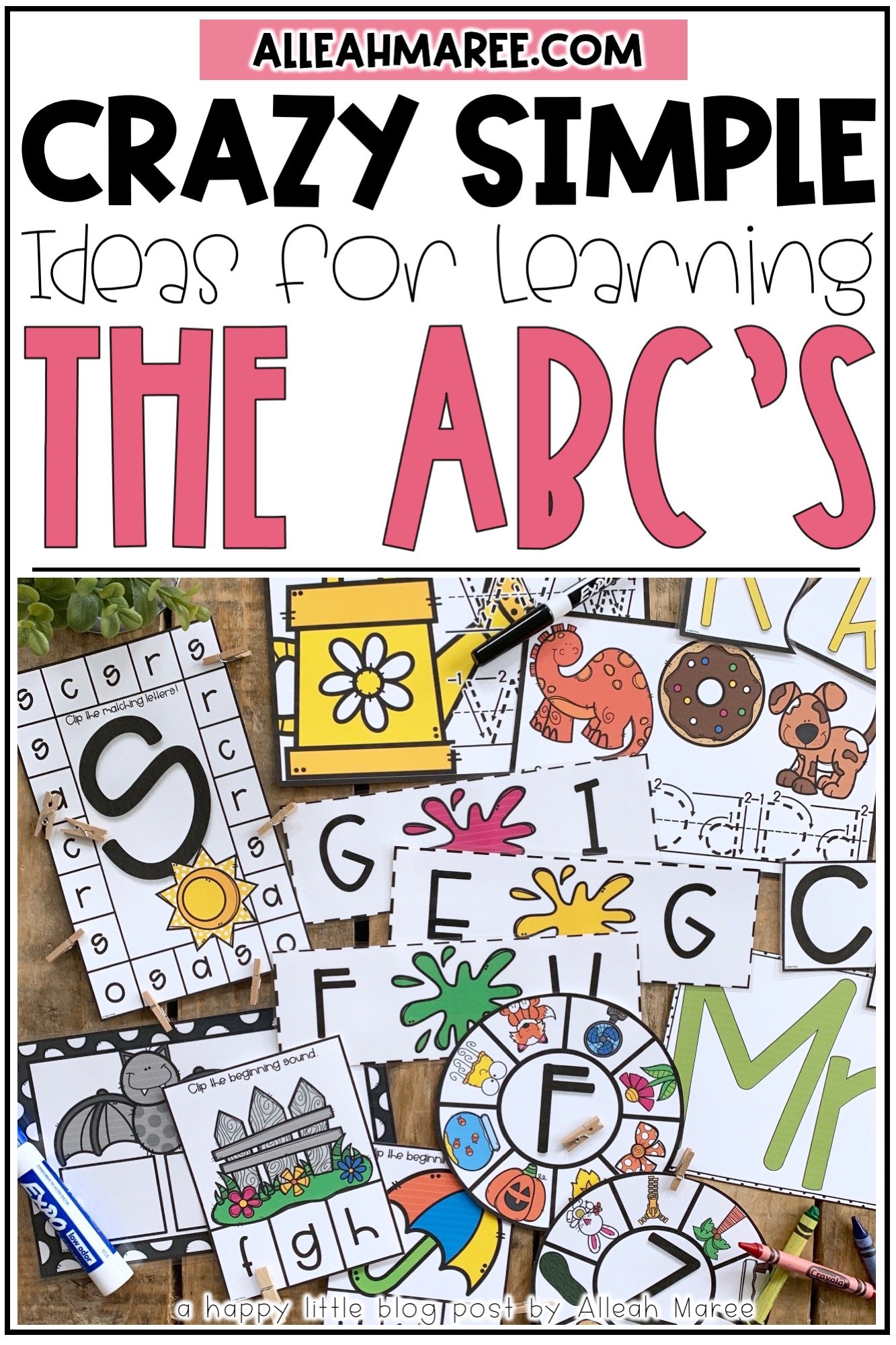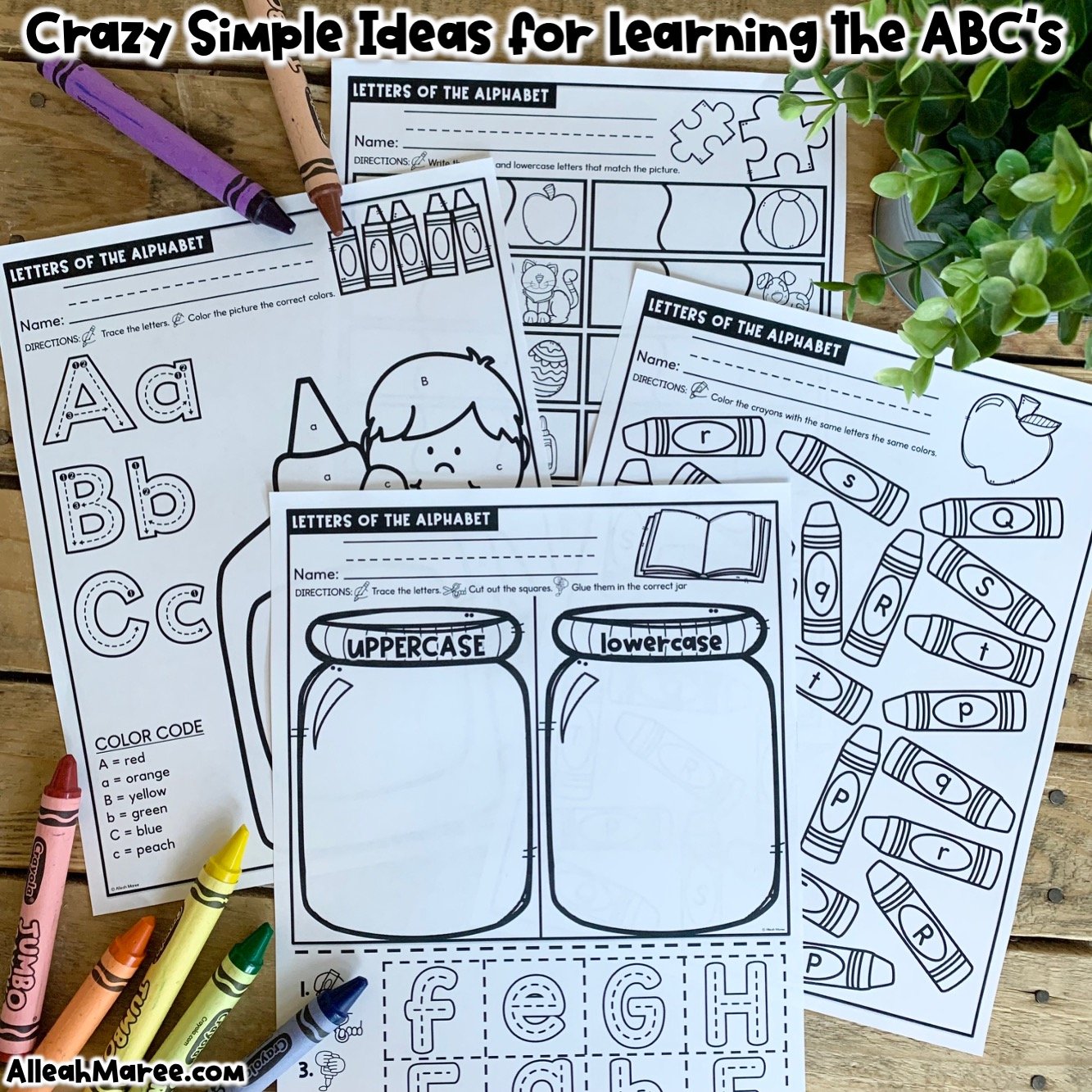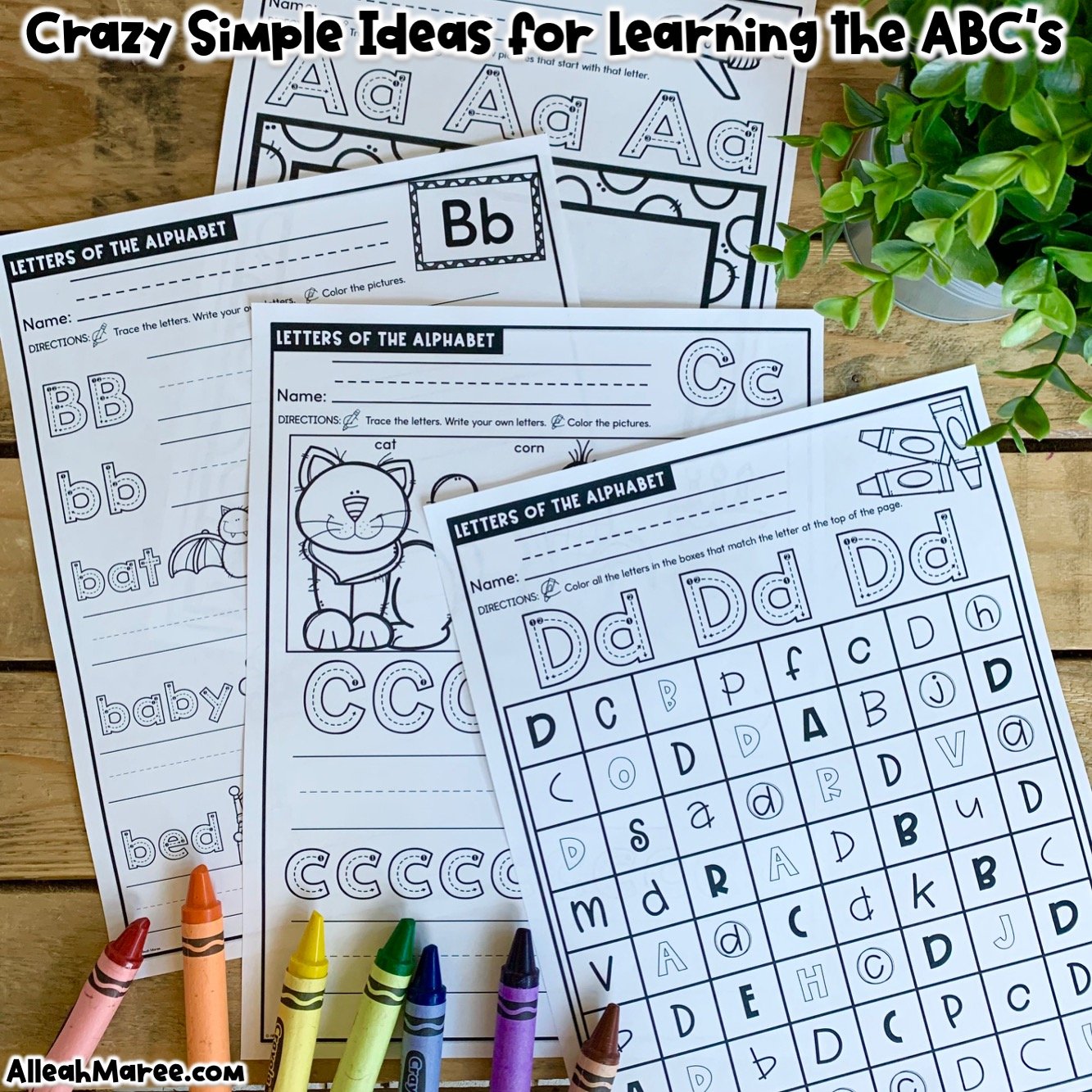Crazy Simple Ideas for Learning the ABC's
Are you looking for ways to encourage TONS of early literacy skills without needing much more than some time together and an activity or two? I have some super simple, fun ways to strengthen early literacy skills with your toddlers and preschoolers, at home OR in the classroom!
Looking for ways to make letter-learning fun for your little learners? I have some crazy simple, super fun ideas for learning the letters of the alphabet in ways that’ll really stick. Come see!
Ooh, and there are a couple FREE LETTER ACTIVITIES for you near the end of this post!
1. Letter Busy Boxes
Letter Busy Boxes are a super fun way to practice letters by focusing on one specific letter at a time. Sometimes, when kids are first learning the ways that letters look and sound, focusing on just one letter at a time is a great strategy. As they master each letter, they’re usually ready to move on to the next one.
Letter Busy Boxes are perfect for this kind of approach because you’re introducing one letter at a time in a variety of ways. There are activities for matching, tracing, and identifying the same letter throughout the whole box so that students are exposed to the same look and sound of the letters over and over again as they complete the activities.
Wondering if your learners will love letter busy boxes? Try this alphabet busy box for FREE to find out!
Using hands-on centers is another great way to reinforce letter knowledge. Exposing kids to letters in a variety of ways is so key in helping those letters and sounds to really stick. So, using their hands, brains, and bodies all together to learn the same concept is super effective for retention!
Hands-on centers could include activities like manipulating letter cards and mats, putting together letter puzzles, or matching pictures with letters. Any kind of moving around the center pieces to complete the activities is a good way to help that letter knowledge last.
Again, exposing your little learners to letters in a million ways is GREAT, so why not with play dough?! Your kiddos can create letters on their own or build them as shown on a play dough mat, but either way, seeing those shapes and connecting the shapes with the letter names and sounds is a perfect way to incorporate ABC skills into play time.
They can sing the ABC’s while they build each letter or try to think of words that begin with that letter. Or build a letter and then create a picture that starts with that letter too? Whatever skills your learners are ready for is AWESOME.
After your learners can mostly identify the letter names independently, they can start differentiating between upper and lowercase letters and exploring phonics skills like letter sounds too! But, letters + play dough = the perfect combination of fun and learning!
Okay, here me out! I know worksheets and little ones have a SUPER negative reputation, but I have some really great reasons and scenarios where “worksheets” for little kids are a great tool!
First of all, worksheets offer opportunities to little ones to practice forming the letters in the way they’re going to form them for the REST OF THEIR LIVES. They can’t go to high school writing with play dough, building their essays with blocks, or using paint every class period. 😂 They’re going to need to know how to WRITE their letters. So, worksheets give kids great scaffolding to build up to being able to write their letters independently. Tracing is an ESSENTIAL fine motor skill for little ones, they need lots of practice to learn how to hold a writing utensil correctly, and worksheets are great tool to practice these important skills.
Secondly, the KIND of worksheets and the FREQUENCY of worksheet work is often overlooked. I’m definitely not suggesting you plop down a worksheet full of the whole alphabet and words for your preschoolers to complete EVERY day. But, used appropriately for the level of learners you’re working with, printable activities can be a great TOOL!
For younger learners who are just starting to learn the alphabet, worksheets that focus on one or a couple letters at a time and also have MORE skills besides just writing necessary to complete them are super age appropriate. I love to give my preschooler a printable once or twice a week that requires him to color or trace, cut, glue, and match all in one worksheet! That way, he’s using many parts of his brain and different physical skills to work on the assignment and not JUST coloring or writing.
These CUT AND PASTE WORKSHEETS are some of our favorite ones to pull out throughout the week!
5. Songs
Putting thoughts, skills, concepts, and facts into song form is an awesome way to help people of all ages remember them! Adding rhythm and beat to letter skills and concepts is a guaranteed way to help them remember it, even when they’re not trying.
When I was super young, like 3 or 4 years old, my mom made up a little song to help me remember my full name, phone number, and address in case I was ever in an emergency and wasn’t with her. Y’ALL…I can sing that song TO THIS DAY. I know my childhood phone number and address because she made it into a song!
The best ways I learned to spell words that weren’t spelled phonetically was to add some rhythm to how I said the letters when spelling them. Like, when you spell Mississippi, you don’t just SAY the letters, do you? You kind of sing ‘em…like, M-I-S-S, I-S-S, I-P-P, I! You just sing-song spelled that with me, didn’t you? :)
This concept applies to literally ANY skill. I guarantee if you add a little rhythm to the information as you’re learning it, it’ll stick WAY more concretely and for much longer than just saying or writing them.
You can look up or make up songs to practice letter names, letter sounds, rhyming words, digraphs, blends, simple sight words, or even parts of a story! As long as a little rhythm is there, they’ll get stuck in your kids heads and they’ll be practicing their literacy skills without even knowing it. And that’s a win for everyone!
Here are a few fun ABC songs we like!
6. Manipulatives
Pull out those maniupatives that your littles can physically HOLD! Magnetic letters, letter cubes, Scrabble tiles, play dough, stickers, letter dummies, letter cookies, any letter manipulative you love…get them OUT! :) Young kids really connect with things they can explore with their 5 senses. Use more than one of our senses to learn something or adding an emotional or physical aspect to learning is a proven way to help the knowledge sink in and last longer.
So, tracing letter A, singing about letter A, creating a letter A with play dough, making a row of letter A’s with magnetic letters, and eating a letter A cookie a few times during the week is going to help the look and sound of “letter A” make more connections and develop deeper learning for your young kids.
7. Reading Books
Reading is SO underrated, friends. Haha! Reading books and showing kids how your brain is thinking by noticing and pointing out letters on occasion is such a simple way to reinforce letter knowledge. There are obviously TONS of other literacy skills that you can practice together most books, whether your little one is learning how new vocabulary words, needs to hear proper inflection, tone, and fluency or they’re ready to tackle comprehension by retelling the major parts of the story, incorporating books into your learning routine is a MUST.
📚 Click the titles below to peek at a couple of my favorite books about letters!
Shiver Me Letters: A Pirate ABC
Sensory bins are another super fun way to get your kiddos learning and playing with letters at the same time! Set out a container of dry beans or pom-poms, add in some buttons, mini erasers, or just different-colored beans and my preschooler is ready to dig his hands in and play!
Make it letter focused by tossing in the letter cards from a center activity, some magnetic letters, or letter tiles. My preschooler just turned 4 and we usually use dry pinto beans (with lots of mini erasers and pom poms) to practice matching pictures, letters, or numbers. Click any of the links below to check out some of our favorite letter centers that are perfect to throw into a sensory bin this year. 🙂
St. Patrick’s Day Letter Match
Lucky Charms Letter Puzzles Sensory Bin
FREE Summer Letter Sensory Bin
CLICK HERE to sign up to get access to a BUNCH of free activities to practice letters with in my free resource library. Sign up HERE!
I hope these letter-learnin’ tips have helped you discover a new way or two to get the fun started with your littles! I know your students will pick up these letter skills super quickly using some of these strategies. I’d love to hear how they’re progressing! Feel free to leave a comment or email me if I can help in anyway. :)
Cheering you on always!
✨ Wanna follow me on TPT? CLICK HERE!
✨ Is Instagram more your thing? CLICK HERE!
✨ To peek at my Facebook page, CLICK HERE!
















